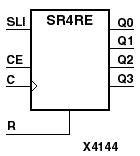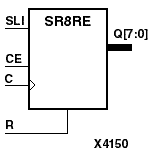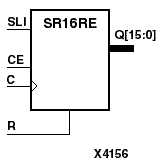| XC3000 | XC4000E | XC4000X | XC5200 | XC9000 | Spartan | SpartanXL | Virtex |
|---|---|---|---|---|---|---|---|
| Macro | Macro | Macro | Macro | Macro | Macro | Macro | Macro |



SR4RE, SR8RE, and SR16RE are 4-, 8-, and 16-bit shift registers, respectively, with shift-left serial input (SLI), parallel outputs (Qn), clock enable (CE), and synchronous reset (R) inputs. The R input, when High, overrides all other inputs during the Low-to-High clock (C) transition and resets the data outputs (Q) Low. When CE is High and R is Low, the data on the SLI is loaded into the first bit of the shift register during the Low-to-High clock (C) transition and appears on the Q0 output. During subsequent Low-to-High clock transitions, when CE is High and R is Low, data is shifted to the next highest bit position as new data is loaded into Q0 (SLI![]() Q0, Q0
Q0, Q0![]() Q1, Q1
Q1, Q1![]() Q2, and so forth). The register ignores clock transitions when CE is Low.
Q2, and so forth). The register ignores clock transitions when CE is Low.
Registers can be cascaded by connecting the last Q output (Q3 for SR4RE, Q7 for SR8RE, or Q15 for SR16RE) of one stage to the SLI input of the next stage and connecting clock, CE, and R in parallel.
The register is asynchronously cleared, outputs Low, when power is applied. For CPLDs, the power-on condition can be simulated by applying a High-level pulse on the PRLD global net. FPGAs simulate power-on when global reset (GR) or global set/reset (GSR) is active. GR for XC3000 is active-Low. GR for XC5200 and GSR (XC4000, Spartans, Virtex) default to active-High but can be inverted by adding an inverter in front of the GR/GSR input of the STARTUP or STARTUP_VIRTEX symbol.
| Inputs | Outputs | ||||
|---|---|---|---|---|---|
| R | CE | SLI | C | Q0 | Qz - Q1 |
| 1 | X | X | 0 | 0 | |
| 0 | 0 | X | X | No Chg | No Chg |
| 0 | 1 | 1 | 1 | qn-1 | |
| 0 | 1 | 0 | 0 | qn-1 | |
| z = 3 for SR4RE; z = 7 for SR8RE; z = 15 for SR16RE qn-1 = state of referenced output one setup time prior to active clock transition | |||||
Figure 10.8 SR8RE Implementation XC3000, XC4000, XC5200, XC9000, Spartans, Virtex |